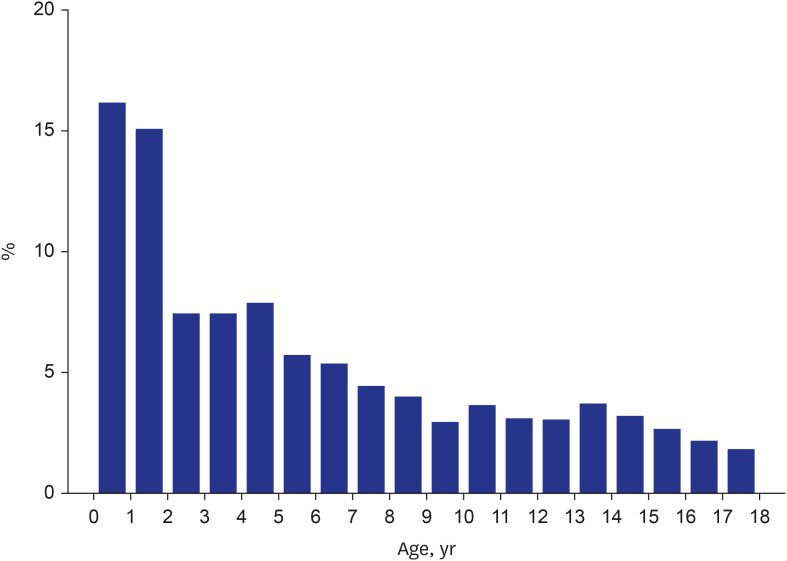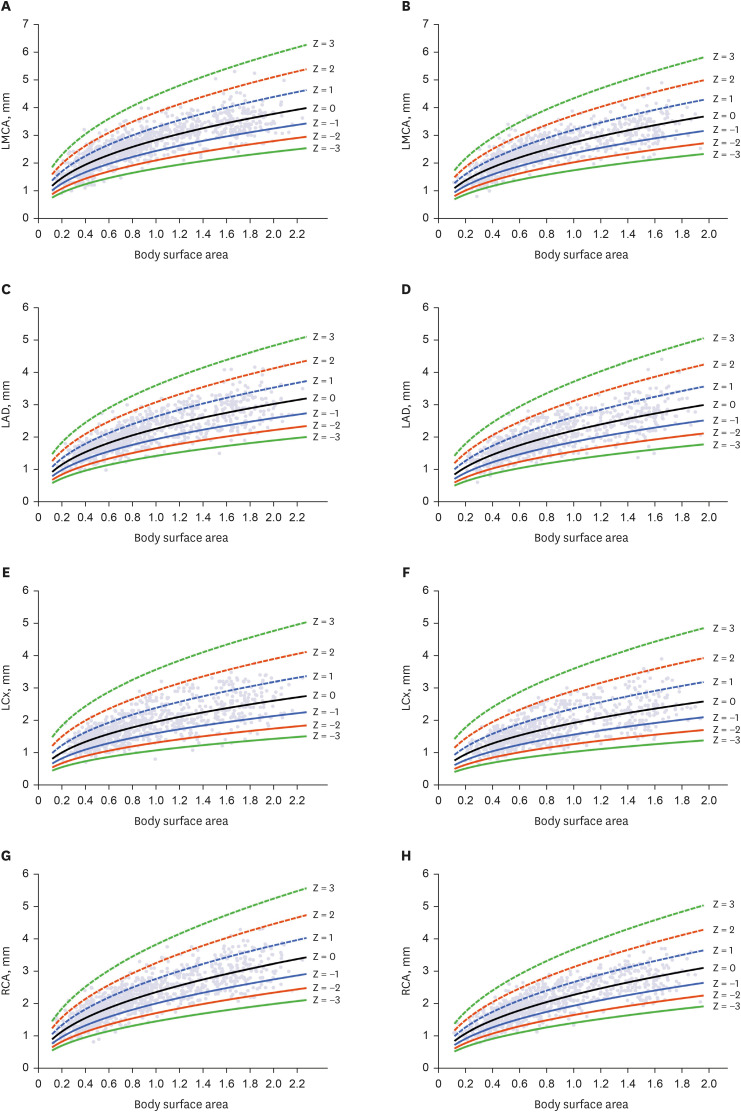J Korean Med Sci.
2024 Apr;39(16):e144. 10.3346/jkms.2024.39.e144.
Newly Developed Sex-Specific Z Score Model for Coronary Artery Diameter in a Pediatric Population
- Affiliations
-
- 1Department of Pediatrics, University of Ulsan College of Medicine, Seoul, Korea
- 2Department of Pediatrics, Keimyung University School of Medicine, Daegu, Korea
- 3Department of Pediatrics, Chonnam National University Medical School, Gwangju, Korea
- 4Department of Pediatrics, CHA Bundang Medical Center, CHA University, Seongnam, Korea
- 5Department of Pediatrics, Chungbuk National University College of Medicine, Cheongju, Korea
- 6Department of Pediatrics, College of Medicine, Seoul National University, Seoul, Korea
- 7Department of Pediatrics, Yonsei University College of Medicine, Seoul, Korea
- 8Department of Pediatrics, Institute of Medical Science, Gyeongsang National University College of Medicine, Gyeongsang National University Hospital, Jinju, Korea
- 9Department of Pediatrics, Presbyterian Medical Center, Jeonju, Korea
- 10Department of Pediatrics, CHA Gangnam Medical Center, CHA University, Seoul, Korea
- 11Department of Pediatrics, Pusan National University School of Medicine, Yangsan, Korea
- 12Department of Pediatrics, Ewha Womans University Medical Center, Seoul, Korea
- 13Department of Pediatrics, Bundang Jesaeng General Hospital, Seongnam, Korea
- 14Department of Pediatrics, Inje University Paik Hospital, Busan, Korea
- 15Department of Pediatrics, College of Medicine, The Catholic University of Korea, Seoul, Korea
- KMID: 2555477
- DOI: http://doi.org/10.3346/jkms.2024.39.e144
Abstract
- Background
This study aimed to generate a Z score calculation model for coronary artery diameter of normal children and adolescents to be adopted as the standard calculation method with consensus in clinical practice.
Methods
This study was a retrospective, multicenter study that collected data from multiple institutions across South Korea. Data were analyzed to determine the model that best fit the relationship between the diameter of coronary arteries and independent demographic parameters. Linear, power, logarithmic, exponential, and square root polynomial models were tested for best fit.
Results
Data of 2,030 subjects were collected from 16 institutions. Separate calculation models for each sex were developed because the impact of demographic variables on the diameter of coronary arteries differs according to sex. The final model was the polynomial formula with an exponential relationship between the diameter of coronary arteries and body surface area using the DuBois formula.
Conclusion
A new coronary artery diameter Z score model was developed and is anticipated to be applicable in clinical practice. The new model will help establish a consensus-based Z score model.
Keyword
Figure
Reference
-
1. Manlhiot C, Brandão LR, Somji Z, Chesney AL, MacDonald C, Gurofsky RC, et al. Long-term anticoagulation in Kawasaki disease: initial use of low molecular weight heparin is a viable option for patients with severe coronary artery abnormalities. Pediatr Cardiol. 2010; 31(6):834–842. PMID: 20431996.2. Friedman KG, Gauvreau K, Hamaoka-Okamoto A, Tang A, Berry E, Tremoulet AH, et al. Coronary artery aneurysms in Kawasaki disease: risk factors for progressive disease and adverse cardiac events in the US population. J Am Heart Assoc. 2016; 5(9):e003289. PMID: 27633390.3. Patel AS, Bruce M, Harrington W, Portman MA. Coronary artery stenosis risk and time course in Kawasaki disease patients: experience at a US tertiary pediatric centre. Open Heart. 2015; 2(1):e000206. PMID: 25815208.4. Miura M, Kobayashi T, Kaneko T, Ayusawa M, Fukazawa R, Fukushima N, et al. Association of severity of coronary artery aneurysms in patients with Kawasaki disease and risk of later coronary events. JAMA Pediatr. 2018; 172(5):e180030. PMID: 29507955.5. Research Committee on Kawasaki disease. Report of Subcommittee on Standardization of Diagnostic Criteria and Reporting of Coronary Artery Lesions in Kawasaki disease. Tokyo, Japan: Ministry of Health and Welfare;1984.6. de Zorzi A, Colan SD, Gauvreau K, Baker AL, Sundel RP, Newburger JW. Coronary artery dimensions may be misclassified as normal in Kawasaki disease. J Pediatr. 1998; 133(2):254–258. PMID: 9709715.7. McCrindle BW, Rowley AH, Newburger JW, Burns JC, Bolger AF, Gewitz M, et al. Diagnosis, treatment, and long-term management of Kawasaki disease: a scientific statement for health professionals from the American Heart Association. Circulation. 2017; 135(17):e927–e999. PMID: 28356445.8. Fukazawa R, Kobayashi J, Ayusawa M, Hamada H, Miura M, Mitani Y, et al. JCS/JSCS 2020 guideline on diagnosis and management of cardiovascular sequelae in Kawasaki disease. Circ J. 2020; 84(8):1348–1407. PMID: 32641591.9. McCrindle BW, Li JS, Minich LL, Colan SD, Atz AM, Takahashi M, et al. Coronary artery involvement in children with Kawasaki disease: risk factors from analysis of serial normalized measurements. Circulation. 2007; 116(2):174–179. PMID: 17576863.10. Olivieri L, Arling B, Friberg M, Sable C. Coronary artery Z score regression equations and calculators derived from a large heterogeneous population of children undergoing echocardiography. J Am Soc Echocardiogr. 2009; 22(2):159–164. PMID: 19084373.11. Dallaire F, Dahdah N. New equations and a critical appraisal of coronary artery Z scores in healthy children. J Am Soc Echocardiogr. 2011; 24(1):60–74. PMID: 21074965.12. Kobayashi T, Fuse S, Sakamoto N, Mikami M, Ogawa S, Hamaoka K, et al. A new Z-score curve of the coronary arterial internal diameter using the lambda-mu-sigma method in a pediatric population. J Am Soc Echocardiogr. 2016; 29(8):794–801.e29. PMID: 27288089.13. Lopez L, Colan S, Stylianou M, Granger S, Trachtenberg F, Frommelt P, et al. Relationship of echocardiographic z scores adjusted for body surface area to age, sex, race, and ethnicity: the Pediatric Heart Network Normal Echocardiogram Database. Circ Cardiovasc Imaging. 2017; 10(11):e006979. PMID: 29138232.14. Robinson DL, Ware AL, Sauer MC, Williams RV, Ou Z, Presson AP, et al. Implications of changing z-score models for coronary artery dimensions in Kawasaki disease. Pediatr Cardiol. 2021; 42(2):432–441. PMID: 33394108.15. Kim SH, Kim JY, Kim GB, Yu JJ, Choi JW. Diagnosis of coronary artery abnormalities in patients with Kawasaki disease according to established guidelines and z score formulas. J Am Soc Echocardiogr. 2021; 34(6):662–672.e3. PMID: 33422668.16. Hong YM. The diameter of coronary arteries in infants and children without heart disease. J Korean Pediatr Soc. 1990; 33(10):1353–1361.17. Yu JJ, Cho SK, Park YM, Lee R, Chung S, Bae SH. Coronary artery diameter of normal children aged 3 months to 6 years. Korean J Pediatr. 2008; 51(6):629–633.18. Haycock GB, Schwartz GJ, Wisotsky DH. Geometric method for measuring body surface area: a height-weight formula validated in infants, children, and adults. J Pediatr. 1978; 93(1):62–66. PMID: 650346.19. DuBois D, DuBois E. A formula to estimate the approximate surface area if height and weight be known. Arch Intern Med (Chic). 1916; 17:863–871.20. Tsuda E, Kamiya T, Ono Y, Kimura K, Kurosaki K, Echigo S. Incidence of stenotic lesions predicted by acute phase changes in coronary arterial diameter during Kawasaki disease. Pediatr Cardiol. 2005; 26(1):73–79. PMID: 15136903.21. Tsuda E, Tsujii N, Hayama Y. Cardiac events and the maximum diameter of coronary artery aneurysms in Kawasaki disease. J Pediatr. 2017; 188:70–74.e1. PMID: 28662948.22. Ronai C, Hamaoka-Okamoto A, Baker AL, de Ferranti SD, Colan SD, Newburger JW, et al. Coronary artery aneurysm measurement and z score variability in Kawasaki disease. J Am Soc Echocardiogr. 2016; 29(2):150–157. PMID: 26386984.23. Ryu K, Yu JJ, Jun HO, Shin EJ, Heo YH, Baek JS, et al. A comparative study of established z score models for coronary artery diameters in 181 healthy Korean children. Korean J Pediatr. 2017; 60(11):373–378. PMID: 29234361.
- Full Text Links
- Actions
-
Cited
- CITED
-
- Close
- Share
- Similar articles
-
- A comparative study of established z score models for coronary artery diameters in 181 healthy Korean children
- Diagnosis of coronary artery abnormalities in Kawasaki disease: recent guidelines and z score systems
- Three Cases of Coronary Artery Fistula from Right Coronay to Left Ventricle
- A Case of Single Coronary Artery c Effort Angina
- A case of coronary artery true aneurysm developed after stent implantation



